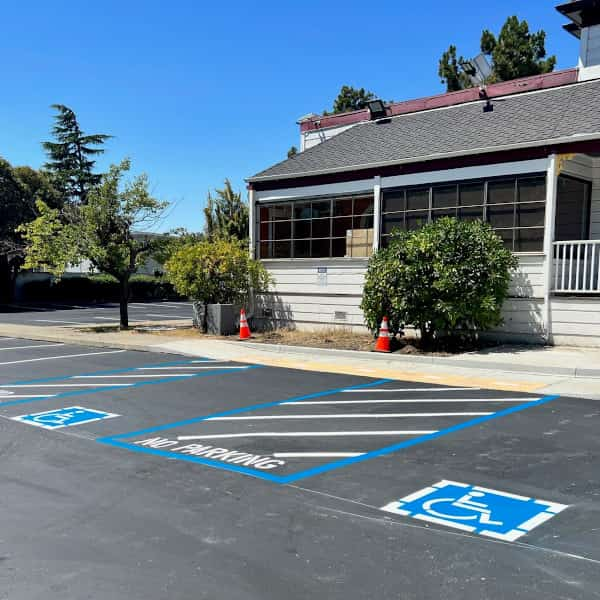CA License #995715
Open Hours: Mon-Fri 8:00AM - 5:00PM

Asphalt parking lots are essential for many businesses and organizations, providing a safe and convenient place for customers and employees to park their vehicles. Unfortunately, these areas are often neglected until significant issues arise, leading to costly repairs. Knowing the common problems associated with asphalt parking lots can help property owners save money by preventing minor issues from becoming large ones. This article will discuss some of the most frequent issues afflicting asphalt parking lots and how to identify them and initiate proper repairs.
It is important to understand the signs of deterioration in order to maintain them properly. There are multiple signs that point to potential damage or deterioration of asphalt parking lots.
The first sign is cracking. Cracks in asphalt can be caused by a variety of things, such as weathering, tree roots growing beneath the pavement, or even heavy traffic on the lot. Additionally, potholes and sunken areas are also a sign that damage has been done to an asphalt parking lot. These can occur when water seeps into the pavement, weakening its structural integrity over time. Owners and managers of asphalt parking lots must regularly inspect their lots for any signs of deterioration so they can take the proper action quickly and efficiently.
Cracking and potholes in asphalt are two of the most common problems. Cracking occurs when the underlying layers of an asphalt parking lot are weakened due to wear and tear. These cracks allow water to seep into the foundation, which can lead to further damage. Potholes form when water accumulates beneath the surface of the parking lot and causes the sub-base to lose its structural integrity.
Both cracking and potholes can be prevented through regular maintenance such as sealing and filling cracks. Also, high-traffic areas such as entryways can be milled and paved. Additionally, proper drainage systems can help reduce pooling water beneath the surface and stop potholes from forming. Taking these preventative measures will ensure that your asphalt parking lot remains in good condition for years to come.
One of the most common problems with asphalt parking lots is drainage issues. According to the National Asphalt Pavement Association, a parking lot should have a minimum slope of 1% for water to flow off properly. If this isn't maintained, it can cause water to pool on the asphalt causing further damage and hazardous conditions.
One common problem with asphalt parking lots is fading color. While this isn’t so much a safety issue, it can lead to a safety issue.
The sun's ultraviolet rays can cause the surface of the asphalt to oxidize, leading to a loss of color. Exposure to water, oil, and other chemicals can accelerate this oxidation process. The result is an unattractive grayish color that can make the lot look old and worn out.
However, the most important part of asphalt fading is a sign the asphalt is losing the bitumen, which binds the aggregate together. The loss of bitumen causes the asphalt to be less flexible and more prone to cracking.
To help prevent fading color and to keep the asphalt flexible it's important sealcoat your parking lot every two or three years. This will help protect against oxidation and keep the lot looking bright and new. Additionally, keeping your parking lot clean by removing debris such as leaves and branches will also help reduce damage from UV rays and other contaminants. Regular maintenance is key to preventing faded colors in asphalt parking lots.
Moving on from the fading color of asphalt parking lots, weeds and grasses growing in the cracks and crevices of the pavement is another common problem. Not only do these unsightly intruders detract from the look of a parking lot, they can also cause damage to the asphalt surface. If left unchecked, weeds and grasses can spread quickly, leading to larger areas of damaged pavement.
To prevent this from occurring, it's important to take action early by removing any weeds or grasses that may be present in the cracks. Doing so will prevent them from taking root and spreading further. Additionally, it's vital to seal any cracks in the pavement to discourage growth. Sealing cracks will not only help prevent weed and grass growth but will also help preserve the structural integrity of the asphalt surface.
Oil spots and stains are the most common problems seen on asphalt parking lots. These occur when oil, grease, or other petroleum-based compounds are spilled onto the asphalt surface. These can be caused by a variety of sources including vehicle fluids, exhaust leaks, and even improper disposal of oil containers. Over time, oil spots and stains can cause damage to the asphalt if not properly addressed.
It is important to act quickly when these appear on the parking lot. The best way to address these is to use an absorbent material such as kitty litter to soak up any excess oil or grease. This should be done immediately after the spill occurs to prevent deep penetration into the asphalt surface and any associated long-term damage. After this step is complete, a professional paving contractor should be contacted for additional repair work if needed.
There are several key steps that can help you maintain your asphalt parking lot:
Keeping your asphalt parking lot in good condition requires ongoing attention and effort – but it's worth it! You'll have a safe space where customers can park their cars with confidence, knowing they won't be met with potholes or cracks upon arrival. Investing in regular maintenance now will save you time and money down the road, so don't delay – get started today!